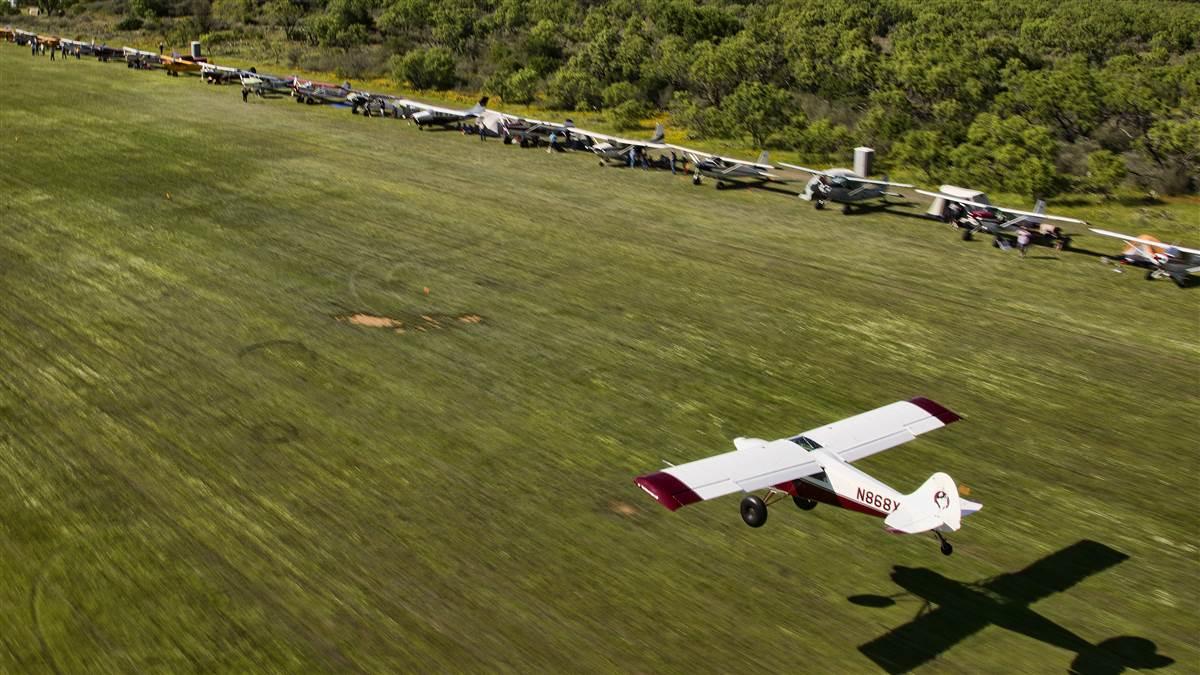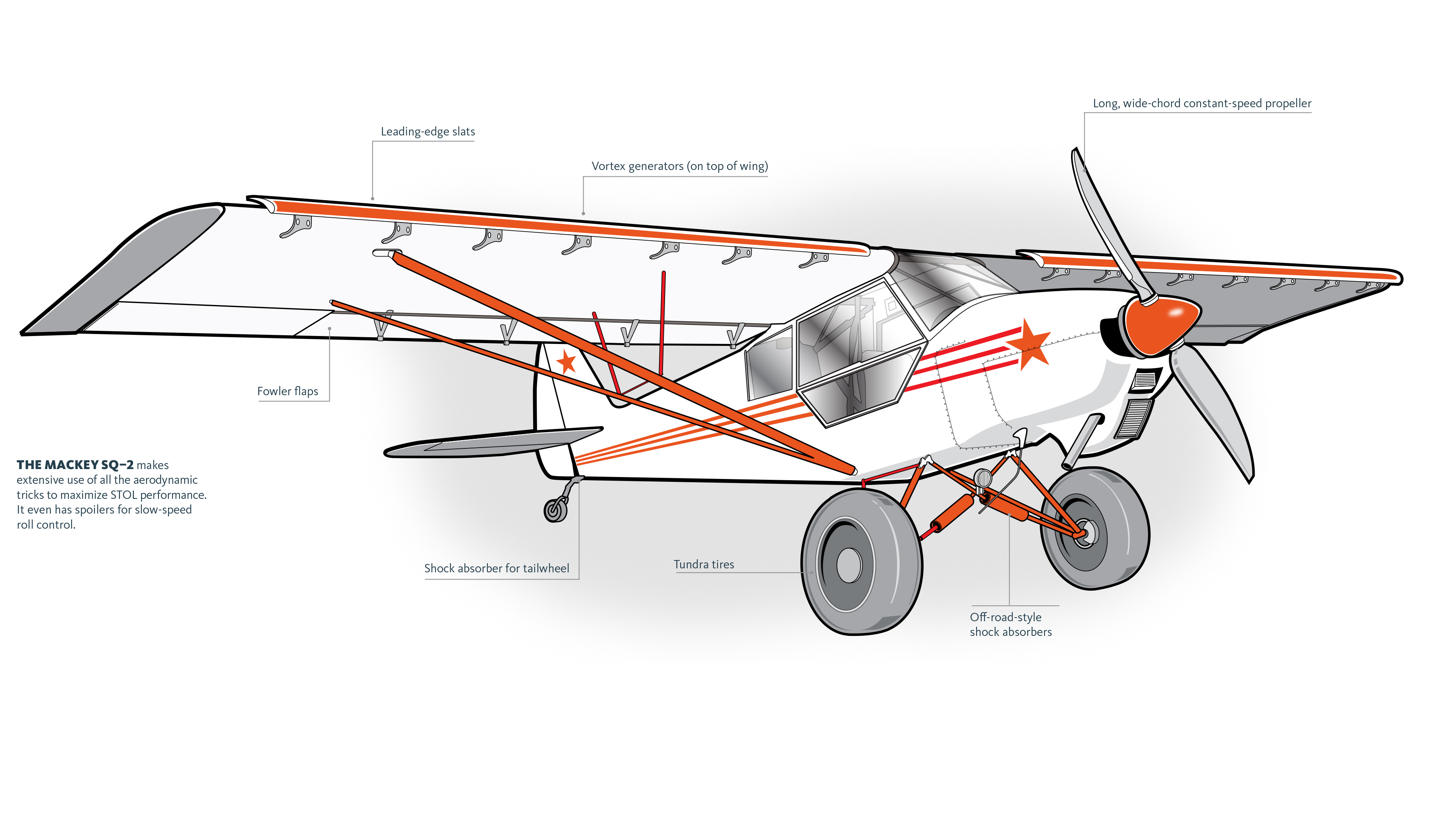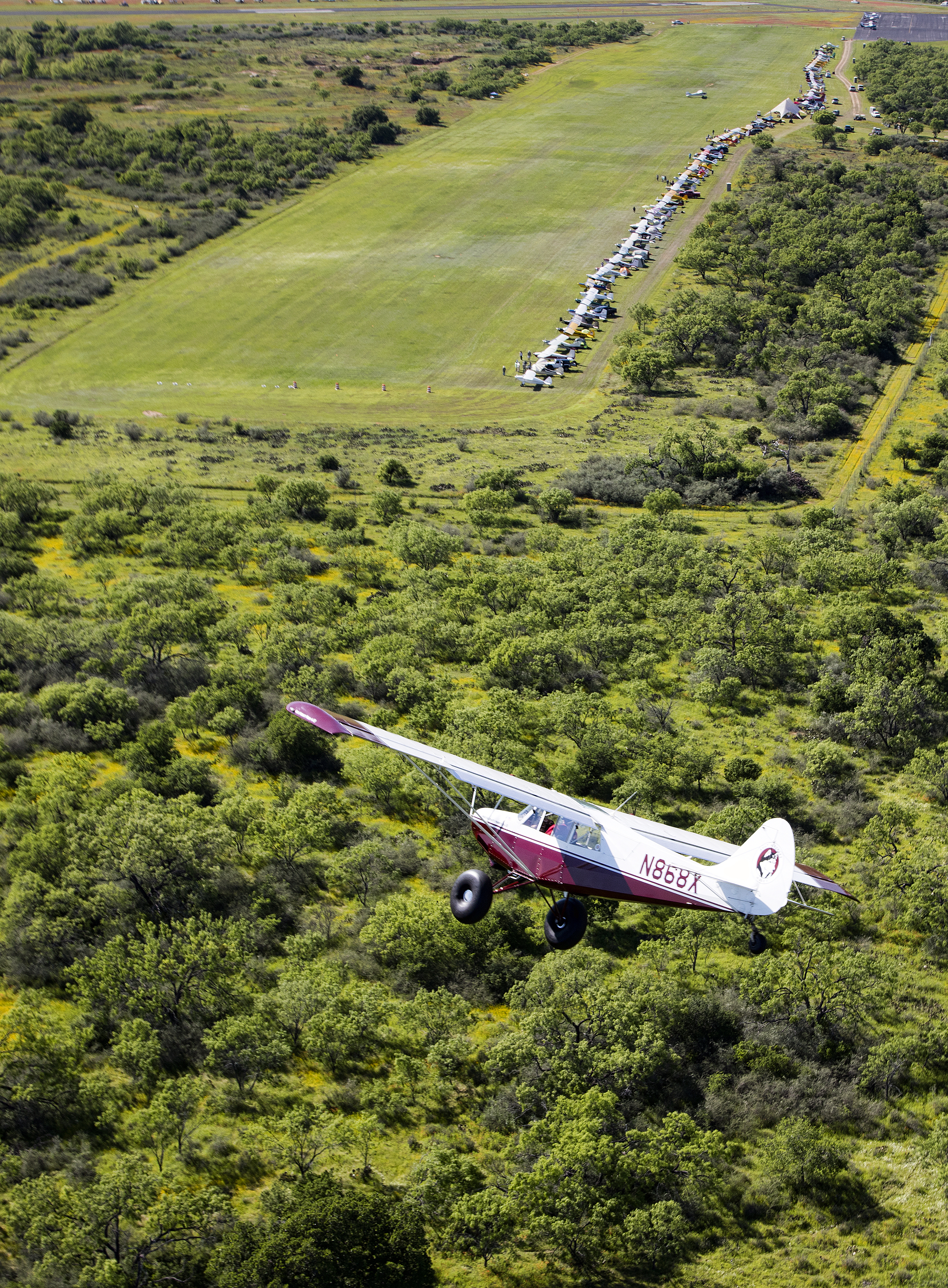Don't Try This At Home
STOL competitions demand extreme techniques

Alaska Pilot Chip Ferguson won both the spot and obstacle landing contests at the Texas STOL Roundup in his stock Aviat Husky.
But if you want to win a short-takeoff-and-landing (STOL) contest, you’ve got to master some unconventional techniques that reduce both safety and aircraft longevity. At the third annual Texas STOL Roundup, a high-wing airplane with 31-inch tundra tires seemed to hang almost motionless as it approached the grass landing area. Nose high, flaps down, engine growling, the kitbuilt SQ–2—a highly specialized backcountry airplane—seemed to defy gravity. It passed just above a pair of inflatable, 25-foot-tall obstacles, and then plummeted the moment the pilot chopped the power. Four shock absorbers on the main landing gear and two on the tailwheel assembly protected the airframe, and the SQ–2 rolled about 80 feet before lurching to a stop. Total landing distance over a 25-foot obstacle: less than 300 feet.
The contest at rural Llano Municipal Airport (AQO) drew about 2,500 spectators, 300 airplanes, and 87 competitors in April 2016. The busy event has quickly become the world’s largest STOL contest.
“Pilots like this event because we’re competitive by nature, we like to have fun, and we all want to improve our skills,” said Phil Whittemore, pilot of the SQ–2 and organizer of the event. “Spectators like it because there’s constant action, cool airplanes, and they recognize the skill and dedication that goes into flying them. You don’t have to be a pilot to get it.”
Piper Super Cubs, CubCrafters Carbon Cubs, Aviat Huskys, tailwheel Cessnas, and a few more exotic aircraft took off and landed in rapid succession. A Quest Kodiak turboprop showed its ruggedness with a no-flare, aircraft carrier-style landing that left an impression (actually two of them, left and right) on the turf. The difference between the first- and second-place finishers frequently came down to just a few feet—and there are no points given for style or subtlety. Coarse but well-timed actions carried the day.
So what gives the winning pilots an edge? Here’s how it’s done, according to Steve Henry. Henry, a Nevada-based pilot and builder of modified Just Aircraft Highlanders, is best known for viral YouTube videos such as Deadstick Takeoff and Landing.
First, make sure your airplane is as light as possible, which means carrying the minimum allowable fuel quantity. In a daytime STOL contest, that’s landing with a 30-minute reserve.

For takeoff, align your airplane with the runway centerline and come to a full stop at the starting line. Tighten the throttle friction lock so that, once advanced, the throttle won’t slide aft on its own after you let go. “The throttle needs to stay firewalled, even when you’re not holding it,” Henry said.
Then add one notch of flaps using the manual flap handle. Doing so will add minimal drag during the takeoff roll, and positioning the handle that way makes it easier to grab later in the takeoff roll, when you’ll forcefully drop the flaps to their full down position.
Then check the gauge on your nitrous oxide tank to make sure the combustion-enhancing gas is warmed to the proper temperature. (You’ve got a nitrous tank, don’t you?) Once the nitrous flow begins, engine power surges about 40 percent instantly. (Henry’s Highlander is equipped with a four-cylinder Rotax engine.)
Hold the brakes hard as you increase engine power and push forward on the control stick. When the tailwheel comes up and the airplane is stationary and in a level attitude, release the brakes and add full power. As the airplane accelerates, hit the nitrous button on the control stick and be prepared for a sudden jolt in speed and P-factor as the long, flat propeller spins up to maximum rpm.
“My engine rpm jumps from about 5,300 to about 5,900 as soon as I give it the nitrous,” he said.
Let go of the throttle, grab the flap handle, and yank it all at once to deploy full flaps. At the same time, pull the control stick all the way aft (full up elevator).
“The airplane just levitates,” Henry said. “Its attitude doesn’t change all that much, but now it’s off the ground and flying.”
From brake release to becoming airborne typically takes about two seconds at sea level with a nitrous boost, Henry said, and the takeoff roll itself is about 100 feet long. That’s less than the length of one white stripe on a typical runway.
Next, the landing. And here again, the technique is highly unorthodox.
“I get the airplane configured on final approach with full flaps—but it’s not a stabilized approach,” Henry said. “I’m holding a high angle of attack very close to an aerodynamic stall, and I’m constantly working the throttle to adjust the rate of descent to hit my aiming point on the ground.”
Henry pumps the brakes and holds both pedals on the floor so that the wheels are locked at the moment they touch down. He also loosens the throttle friction lock so that there’s no resistance when he pulls it all the way to idle.
There’s no flare as Henry nears the ground. A steep descent angle directs the airplane’s energy downward, not forward where it will extend the landing roll. Henry keeps the power on to increase the amount of airflow over the elevator and raises the nose so that the airplane’s tailwheel touches first. Then the main wheels slam down. Shock absorbers and the spongy tundra tires cushion the impact.
Henry holds full aft stick and raises the flaps quickly at touchdown, while pulling the throttle to idle. If the tail comes up during rollout, he lightens the brake pressure momentarily to allow the main wheels to spin. But he prefers leaving them locked if possible.
“In wet grass, the tires will slide and I’ll keep the brakes locked,” Henry said. “The Highlander’s main wheels are unusually far forward, and that allows me to brake aggressively without nosing over.”
Henry performs extreme short-field landings in the backcountry so often that he has to remind himself when he flies cross-country not to lock the brakes on landings. “That technique doesn’t work so well on hard-surface runways,” he said.
The right way
Techniques behind short-field takeoffs and landings
Competition-style STOL contests might be fun to watch, but the pilots use techniques not recommended for everyday flying. For the less extreme version, try this:
Short-field takeoff:
• Set the flaps recommended in the airplane’s operating handbook.
• Line up on the runway centerline.
• Hold the brakes and apply full power.
• Rotate at rotation speed and pitch for VX.
• Hold that climb rate until passing 50 or 100 feet, then lower the nose to VY.
• Retract the flaps at a safe altitude.
Short-field landing:
• Establish a final approach with full flaps and a few knots below the standard approach speed.
• Pick an aiming point short of your touchdown point. Remember that the objective is to land on a spot and stop soon after, not use as little of the runway as possible.
• Reduce power to idle in the roundout and be prepared to touch down soon.
• Apply brakes and full aft yoke.

During the obstacle-landing contest, pilots must clear the 25-foot-tall inflatable pylons before chopping the power and touching down. An approach is shown here in multiple exposures. A judge at eye level with the pylons disqualifies pilots who fly too low.

Competitors wait next to the grass runway at Llano during a practice session.
How Valdez STOL the show
Alaska competition became a YouTube sensation
The port city of Valdez, Alaska, has a population of only 4,000. But the 2016 Valdez Fly-In and Air Show drew a crowd of more than 2,000 in May to watch bush pilots compete for the shortest takeoff and landing distances in the event’s thirteenth annual STOL competition. The annual event has brought Alaska-style short-field operations to a much wider audience online, where videos of fat-tired bushplanes rocketing off the runway and planting back down on the pavement have racked up hundreds of thousands of views. In 2016, Robert Pedersen of North Carolina won the Light Sport class with a takeoff of 54 feet and a 49-foot landing in a Just Aircraft Super STOL.



